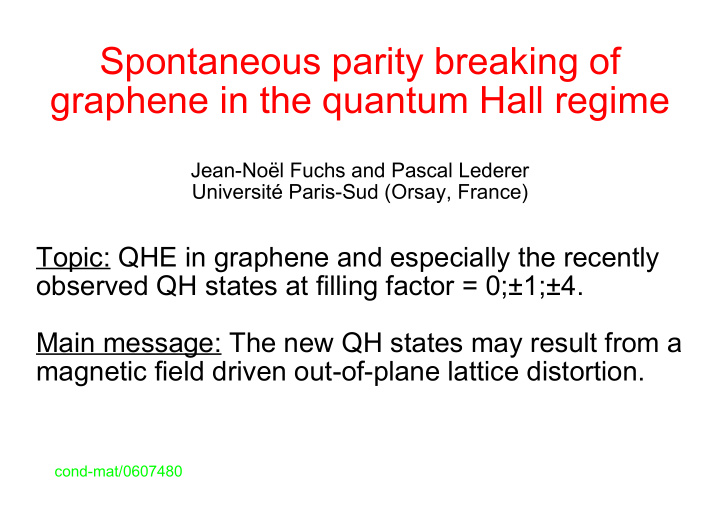



Spontaneous parity breaking of graphene in the quantum Hall regime Jean-Noël Fuchs and Pascal Lederer Université Paris-Sud (Orsay, France) Topic: QHE in graphene and especially the recently observed QH states at filling factor = 0;±1;±4. Main message: The new QH states may result from a magnetic field driven out-of-plane lattice distortion. cond-mat/0607480
Graphene at B=0 graphene contacts A B a Tight-binding model on honeycomb lattice (triangular Bravais lattice with a 2 carbon atom basis: A and B) with hopping t = 3eV: Wallace, Phys. Rev. 1947 Relativistic like dispersion relation close to K and K' : 2 valleys (or chiralities or pseudo-spin): α = ±1 2 spin states: σ = ±1 Half-filled big band (= valence+conduction bands) at zero gate voltage V g = 0.
Graphene at small B: relativistic QHE B ≈ 10 T Integer n = LL index 10 6 McClure Phys. Rev. 1956. 2 -2 -6 -10 Novoselov et al., Nature 2005; Zhang et al., Nature 2005.
Graphene at large B: extra QH states Th.: Landau levels + Zeeman: Exp.: filling factor = 0;±1;±2;±4;±6 filling factor = 0;±2;±4;±6;±8;etc. but not filling factor = ±3;±5 6 37T 42T 45T 4 2 0 1 -1 -2 -4 -6 30T 9T 25T Zhang et al., Phys. Rev. Lett. 2006.
Mechanisms of valley splitting 1) Valley-Zeeman effect - Uniaxial stress (e.g. applied via a piezo): doesn't lift the valley degeneracy in graphene. 2) Electron-electron interactions - Exchange gap (QH valley ferromagnetism) - Excitonic gap (“magnetic catalysis”) - El.-el. Interactions at the lattice scale (QH valley “paramagnetism”) 3) Electron-phonon interactions - Magnetic field driven out-of-plane Peierls distortion
Parity breaking of the honeycomb lattice If A and B atoms are different (e.g. boron nitride) then the honeycomb lattice's inversion symmetry is broken and the valley degeneracy is lifted (in n=0). B A A and B carbon atoms are now assumed to be different. Tight-binding model with different on-site energies ±M (Haldane, PRL 1988): Central Landau level (n=0): α = +1 = A and α = -1 = B Not true for the other Landau levels (n≠0)
Magnetic field driven Peierls distortion How can one have A ≠ B? Out-of-plane lattice distortion AND substrate (SiO2) ≠ superstrate (air) B moves towards the silicon dioxide substrate (-η) A moves away from the substrate (+η) Electronic energy (gain): Elastic energy (cost): Effective elastic energy: Total energy: Minimizing the total energy:
Estimate of the constants D and G G = elastic constant corresponding to the out-of-plane optical phonon mode (ZO) (for graphite) D = “deformation potential”, coupling to the substrate Rough estimate of the coupling to the substrate via the Lennard-Jones interaction of a carbon atom with the substrate: Da ≈ 1 to 14 eV No deformation when B=0: G' > 0 therefore Da < 9,8eV Valley splitting is larger than Zeeman splitting if Da > 6.3eV To explain the experiments, we choose Da ≈ 7.8 eV, therefore G'a 2 ≈ 4,2eV
Conclusion: experimental tests Experiments should decide which mechanism is responsible for lifting the valley degeneracy in graphene. Out-of-plane lattice distortion implies: -- Valley gap as a function of the magnetic field: -- Valley gap as a function of the gate voltage: -- Lattice distortion: X-ray diffraction at grazing incidence; STM; Helium surface diffraction; etc. -- IR absorption spectroscopy of the ZO phonons -- In a symmetric dielectric environnement, the lattice distortion should vanish (e.g. for a suspended graphene sheet or for a sheet inside a polymer matrix, see R. Ruoff). cond-mat/0607480
Thank you!
Recommend
More recommend